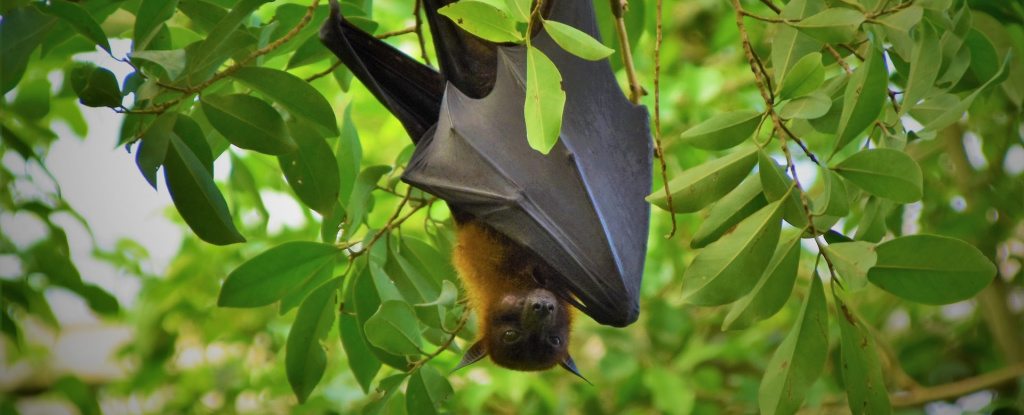Products You May Like
The link between habitat destruction, climate change, and the emergence of new viruses has never been more evident than during the pandemic.
The arrival of SARS-CoV-2 and the spread of COVID-19 brought into sharp focus how human activities such as deforestation can bring wild animals bearing viruses closer to humans.
In a new study, researchers sought to provide more granular data collected over 25 years in Australia to illustrate the connections between habitat loss, animal behavior, and viral spillover.
Specifically, the scientists looked at the bat-borne Hendra virus, which mainly infects fruit bats (also known as flying foxes); the virus can jump over into humans via horses.
“Interactions between land-use change and climate now lead to persistent bat residency in agricultural areas, where periodic food shortages drive clusters of spillovers,” behavioral ecologist Peggy Eby of the University of New South Wales in Australia and colleagues write in their published paper.
Zoonotic spillover describes how viruses and other pathogens found in animals can leap into humans, sometimes with deadly consequences. Hendra virus is one example; HIV, Ebola, rabies, and the plague make a grim shortlist of other zoonotic diseases.
Hendra virus – named after the Brisbane suburb where it was discovered in 1994 – can cause severe or even fatal illness in humans and horses. Most often, infected bats feeding in horse paddocks transmit the virus, and since 2006, the frequency and range of Hendra virus spillovers in Australia have increased.
In this study, Eby and colleagues dug into decades of data to study rapid changes in bat behavior that coincided with Hendra virus spillover events in southwest Queensland between 1996 and 2020. The timing and location of these events were mapped against data on bat roosting sites, foraging areas, local climate, food supplies, and habitat loss.
“From approximately 2003 through 2020, bat behavior and the incidence of spillovers changed rapidly: The number of roosts tripled, and 40 spillovers were detected,” Eby and colleagues report.
Fitting the data to a statistical model, the researchers showed how climate and land-use changes drive bats to live in agricultural and urban areas, increasing the risk of Hendra virus spillover into horses.
By 2018, nearly a third of natural fruit bat habitat in 1996 had been cleared, sending bats flocking to urban areas to roost, though most spillover events (86 percent) occurred in agricultural areas where horses roam.
Drought-inducing El Niño events also caused winter food shortages for bats, heralding an increase in roosts closer to human-populated areas where bats could presumably find food.
Not only do food shortages and habitat loss thrust bats into areas where humans and horses live – increasing the number of human-animal encounters – but past research suggests nutritional stress can lead to increased viral shedding in bats.
“The timing of Hendra virus spillover clusters in winter, months after the food shortages in the previous year, may be due to the cumulative effects of nutritional stress overlaying high energy requirements in winter (thermoregulation and pregnancy) and scarce resources within suboptimal habitats,” the researchers write.
When nearby native forests flowered profusely in winter – something which is becoming increasingly rare – the bats reverted to their usual nomadic lifestyle, vacating urban and agricultural areas in favor of their natural habitat, and spillover events did not occur during these periods.
Protecting remnants of native forests, particularly winter-flowering forests that provide nourishment when food is scarce, “could be a sustainable, long-term strategy to reduce spillover and protect the health of livestock and humans,” the researchers conclude.
Reproducing a study like this in other areas where zoonotic diseases are common could reveal the dynamics contributing to those outbreaks and inform strategies to curb the risk of infections.
But long-term data stretching back decades on viral reservoir hosts, especially bats, are sparse. And even with our data, it keeps coming back to the same problem: Humans consistently destroying habitats and bulldozing biodiversity.
A 2020 analysis of around 6,800 ecological communities on 6 continents found that as biodiversity declines, the animals that survive and thrive, such as bats and rats, are also the ones more likely to host potentially dangerous pathogens, concentrating the risk of zoonotic disease outbreaks.
“We’ve been warning about this for decades,” Kate Jones, an ecological modeler at University College London who co-authored that study, told Nature when it was published in August 2020.
“Nobody paid any attention.”
The latest study was also published in Nature.
